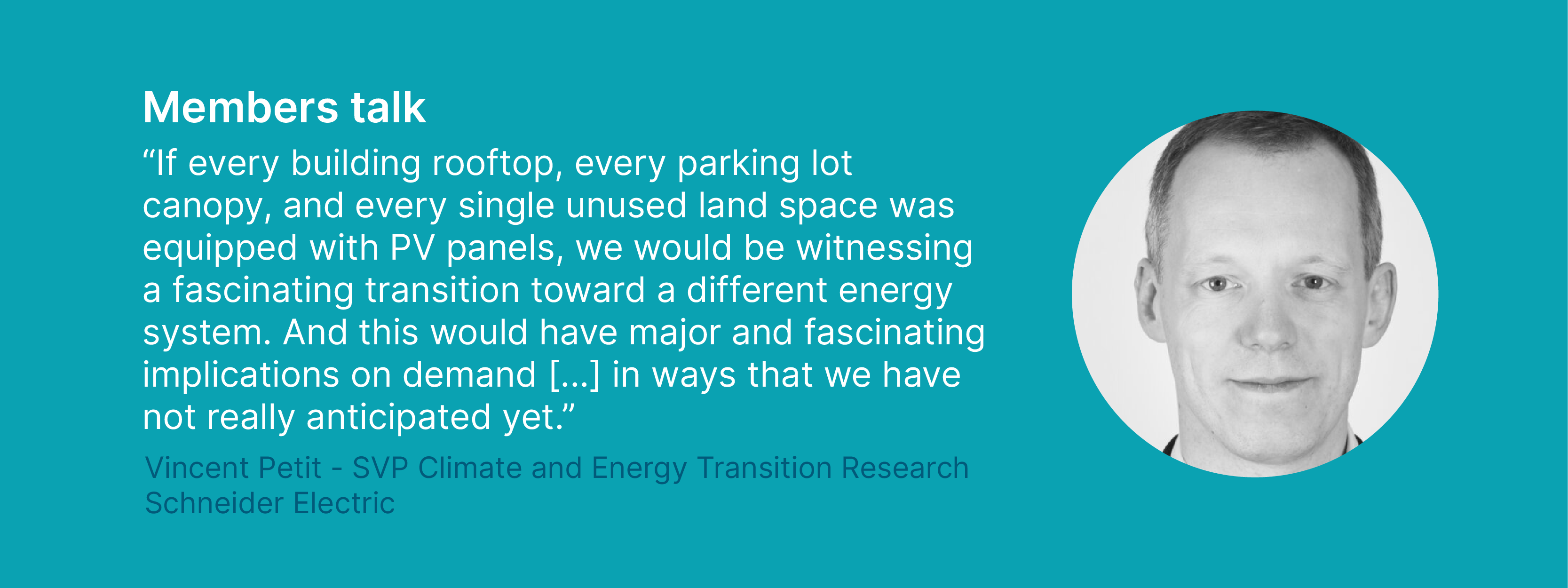Get to know our members and what being part of the ETC means to them. We are pleased to share an exclusive interview with Vincent Petit, SVP Climate and Energy Transition Research at Schneider Electric.

What drew your organisation to join the ETC?
We joined the Energy Transitions Commission (ETC) upon its creation in 2016, inspired by its ambition. The ETC, which was founded as a follow up of the Paris Agreement, aimed at building a force for change by creating an ambitious yet realistic, credible voice in the climate and energy conversation. It did so by coalescing a unique group of institutions, NGOs, and a variety of industries. To a large extent, the success of the ETC owes to this unique blend of sustainability experts who are also passionate practitioners from various horizons and different viewpoints. There was no such organization before the ETC.
And, as a result, its work is also quite unique. The ETC has helped to take the world beyond “What should be done”, into the realm of “How to get it done”, with a credibility that is now internationally recognized. And this recognition precisely comes from the fact that such findings are backed by all parties ultimately involved into making it happen, what drives both strong practicality and open-mindedness.
What do you see as the ETC’s most impactful achievement since you’ve been a Commissioner/Representative?
The core message of the ETC has remained the same from the onset: the transition to a net-zero economy is not only technically achievable, but also economically possible, and for many sectors actually beneficial.
The first flagship report from 2017, Better Energy, Greater Prosperity, was for me a turning point in the discussion at the time, as it clearly demonstrated the major and underrated role of electrification, coupled with renewable energies, in decarbonizing rapidly and efficiently entire sectors of our economy. The clarity of the statement at the time was a clear breakthrough, and we can measure its success to how it has now been picked up by all major institutions around the world, what was not the case at the time.
Closer to us is the work on hard-to-abate sectors (Mission Possible), a term now part of the standard vocabulary of decarbonization (and invented by the ETC if I am not mistaken!). This report clearly demonstrated for the first time that decarbonizing those sectors was in fact readily achievable.
Even more recently, the work from the ETC on how to accelerate the ramp up of renewable power is another unique contribution to the debate, proving once again that much faster rates of penetration are achievable.
What do you see as the biggest obstacle on the journey to net-zero?
Traditionally, the question the world has tried to answer is “How to switch from non-sustainable resources to sustainable ones?”, which can be described as a supply-centric approach. This approach is reductive, as it implies that nothing else in the system must change. In fact, and as demonstrated by the ETC, achieving a net-zero economy by mid-century will require more than switching from one energy source to another. We must also rethink “What we do with energy”, or how we tackle the demand side of the equation. This is critical, because looking at the problem this way opens a score of solutions that can effectively make the transition more rapid, more economically feasible, and more equitable. A very important contribution to this by the ETC, as an example, was the work on circularity engaged in the Mission Possible report.
Next, if the future of the energy system is to be 70% electric by 2050, as projected by the ETC, we need to increase 3-5 times the size of our electricity system. To put it simply, we need plenty of electricity. Clearly, we are late on this agenda, which makes the transition look like a race against scarcity, while it should be one toward abundance. I would even argue that we should not be shy to build more capacity than we think we need, at least for now, simply because future abundance of electricity will also further tilt some of the transitions in demand I mentioned above, in ways that we may not have anticipated just yet.
What are the key milestones you see on the road to net-zero, and why?
2030 is right around the corner. The IPCC is clear, if nothing changes, we will hit the 1.5°C carbon budget limit by then, or before… What needs to be done has already been documented, notably by the ETC in its Keeping 1.5°C Alive report. We only have 7 years left, but a lot can still be achieved within this time frame!
Starting with decarbonizing at scale, and at a much faster pace, all those sectors for which solutions exist and are already (or close to be) competitive. Buildings and road mobility are prime examples. The power sector is another one. Large segments of industry are also concerned. The barriers that prevent more rapid adoption are often self-inflicted. Think of building regulations, or permits for renewable energies, as a few examples. A global overhaul is needed.
Another important milestone will be reached when we stop building new (long-lived) assets designed to rely on the current energy system, one that we are attempting to move away from. Another self-inflicted problem.
What is the one necessary change you feel most personally passionate about in the transition journey?
The list is too long to fit in here. If I am to pick one only, I would highlight distributed generation.
As mentioned above, we need plenty of electricity. The potential of distributed generation (rooftop PV) has been hugely overlooked, in terms of the rapid contribution it could bring, the size of its potential, as well as the benefits it entails for consumers. PV panels, by their nature, are distributed solutions, meaning they can be deployed anywhere close to where there is demand for electricity. Distributed generation is as pervasive as electricity itself, and it is a question of focus again to anticipate a future state that unlocks its full potential.
If every building rooftop, every parking lot canopy, and every single unused land space was equipped with PV panels, we would be witnessing a fascinating transition toward a different energy system.
And this would have major and fascinating implications on demand, because both would be coupled in ways that we have not really anticipated yet. A nice example is the future of buildings and construction. It is hard to imagine that we will keep erecting buildings in 30 years in the way we have been doing it for decades. We should pay more attention to such untold transformations.


